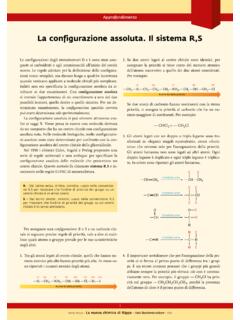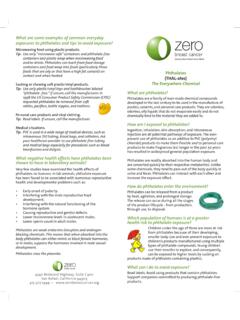Transcription of Chemical composition and ... - Acta Chimica Slovaca
1 Acta Chimica Slovaca , , , 2009, 115 - 138. Chemical composition and nutritional quality of wheat grain Zuzana ramkov a*, Edita Gregov b, Ernest turd ka a). Institute of Biochemistry, Nutrition and Health Protection, Slovak University of Technology Radlinsk ho 9, 812 37 Bratislava, Slovak Republic b). Research Institute of Plant Production, Slovak Centre of Agricultural Research, Bratislavsk 122, 921 68 Pie any, Slovak Republic Review Abstract Deficiencies of micronutrients such as iron, zinc, and vitamin A ( hidden hunger ) afflict over three billion people. Currently there is an increasing preference among consumers for foods that contain not only traditional nutrients but also provide other compounds that are beneficial to health and well-being. Food systems that feed the world must be changed in ways that will insure that balanced nutrient supplies are available continuously to all people in adequate, affordable amounts.
2 This paper reviews about the most important wheat grain components and their nutritional value. The opportunities of plant breeding and other technologies to improve the nutritional quality of wheat are also discussed. Keywords: fibre, micronutrients, proteins, starch, wheat grain Introduction The nutritional value of wheat is extremely important as it takes an important place among the few crop species being extensively grown as staple food sources. The importance of wheat is mainly due to the fact that its seed can be ground into flour, semolina, etc., which form the basic ingredients of bread and other bakery products, as well as pastas, and thus it presents the main source of nutrients to the most of the world population. A huge increase in demand for cereals is predicted if the food needs for the estimated world population growth are to be met. But there is another potentially great benefit to these communities and that is the possibility to ensure such staple crops are nutritionally-balanced Z.
3 Ramkov et al., Chemical composition and nutritional quality of wheat grain 116. and help remove the millions of cases of nutritionally-related deficiency disease that afflict them. It should be emphasised that in the past there has not been a single instance where plants have been bred to improve their nutritional content. If this has occurred it is purely by accident not design (Lindsay 2002; Welch and Graham 2002). Over three billion people are currently micronutrient ( micronutrient elements and vitamins) malnourished. This global crisis in nutritional health is the result of dysfunctional food systems that do not consistently supply enough of these essential nutrients to meet the nutritional requirements of high-risk groups (Welch 2005). One sustainable agricultural approach to reducing micronutrient malnutrition among people at highest risk ( resource- poor women, infants and children) globally is to enrich major staple food crops with micronutrients through plant-breeding strategies.
4 Available research has demonstrated that micronutrient-enrichment traits are available within the genome of wheat (as well as other food crops) that could allow for substantial increases in the levels of minerals, vitamins and other nutrients and health-promoting factors without negatively impacting crop yield. Importantly, micronutrient bioavailability issues must be addressed when using a plant- breeding approach to eliminate micronutrient malnutrition. Enhancing substances ( ascorbic acid, S-containing amino acids, etc) that promote micronutrient bioavailability or decreasing antinutrient substances ( phytate, polyphenolics, etc) that inhibit micronutrient bioavailability, are both options that could be pursued in breeding programs (Welch 2002;. Welch and Graham 2004; Welch 2005). Grain anatomy The fruits of most plants contain one or more seeds, which, at ripeness, can be easily separated from rest of the fruit tissue.
5 For Germineae this is different: fruit wall (pericarp) and seed coat are united. As a result the seed and fruit cannot be separated. This type of fruit, which is characteristic for all grasses, including cereals, is given the botanical term of caryopsis. Wheat grains are generally oval shaped, although different wheats have grains that range from almost spherical to long, narrow and flattened shapes. The grain is usually between 5 and 9mm in length, weighs between 35 and 50mg and has a crease down one side where it was originally connected to the wheat flower. The wheat grain (Fig 1) contains 2-3%. Acta Chimica Slovaca , , , 2009, 115 - 138. Z. ramkov et al., Chemical composition and nutritional quality of wheat grain 117. germ, 13-17% bran and 80-85% mealy endosperm (all constituents converted to a dry matter basis) (Belderok et al., 2000). Fig. 1 Wheat grain (from Encyclopaedia Britannica, ). The bran (outer layers of wheat grain) is made up of several layers, which protect the main part of the grain.
6 Bran is rich in B vitamins and minerals; it is separated from the starchy endosperm during the first stage of milling. In order to protect the grain and endosperm material, the bran comprises water-insoluble fibre. More than half the bran consists of fibre components (53%). Chemical composition of wheat bran fibre is complex, but it contains, essentially, cellulose and pentosans, polymers based on xylose and arabinose, which are tightly bound to proteins. These substances are typical polymers present in the cell walls of wheat and layers of cells such as aleurone layer. Proteins and carbohydrates each represent 16% of total dry matter of bran. The mineral content is rather high (7,2%). The two external layers of the grain (pericarp and seed coat) are made up of dead empty cells. The cells of the inner bran layer- aleurone layer are filled with living protoplasts. This explains the rather high levels of protein and carbohydrate in the bran.
7 There are large differences between the levels of certain amino acids in the aleurone layer and those in flour. Glutamine and proline levels are only about one half, while arginine is treble and alanine, asparagine, glycine, histidine and lysine are double those in wheat flour (Cornell 2003). Acta Chimica Slovaca , , , 2009, 115 - 138. Z. ramkov et al., Chemical composition and nutritional quality of wheat grain 118. The endosperm is surrounded by the fused pericarp and seed coat. The outer endosperm, the aleurone layer, has a special structure: it consists of single layer of cubic shaped cells. The aleurone layer is rich in proteins and enzymes, which play a vital role in the germination process. The inner endosperm, the endosperm without the aleurone layer, is referred to as mealy or starchy endosperm. The endosperm mainly contains food reserves, which are needed for growth of the seedling, it is rich in energy-yielding starch.
8 Apart from carbohydrates, the mealy endosperm contains fats (1,5%) and proteins (13%): albumins, glubulins and the major proteins of the gluten complex- glutenins and proteins that will form the gluten at dough making. The contents of minerals (ash) and of dietary fibers are low; 0,5% and 1,5%, respectively (Belderok et al., 2000). The germ lies at one end of the grain. It is rich in proteins (25%) and lipids (8-13%). The mineral level is also rather high (4,5%). Wheat germ is available as a separate entity because it is an important source of vitamin E. Wheat germ has only one half the glutamine and proline of flour, but the levels of alanine, arginine, asparagine, glycine, lysine and threonine are double (Cornell 2003). Proteins Classification and function Protein is considered the most important nutrient for humans and animals, as manifested by the origin of its name, from the Greek proteios for primary.
9 The protein content of wheat grains may vary between 10% - 18% of the total dry matter. Wheat proteins are classified according to their extrability and solubility in various solvents. Classification is based on the classic work of Osborne at the turn of the last century. In his procedure, sequential extraction of ground wheat grain results in the following protein fractions: albumins, which are soluble in water;. globulins, which are insoluble in pure water, but soluble in dilute NaCl solutions, and insoluble at high NaCl concentrations;. gliadins, which are soluble in 70% ethyl alcohol, and;. glutenins, which are soluble in dilute acid or sodium hydroxide solutions. Albumins are the smallest wheat proteins, followed in size by globulins. The separation of albumins and globulins turned out to be not as clear as initially suggested by Osborne. Gliadins and glutenins are complicated high-molecular weight proteins.
10 Most of Acta Chimica Slovaca , , , 2009, 115 - 138. Z. ramkov et al., Chemical composition and nutritional quality of wheat grain 119. physiologically active proteins (enzymes) in wheat grains are found in the albumin and globulin groups. In cereals, the albumins and globulins are concentrated in the seed coats, the aleurone cells and the germ, with a somewhat lower concentration in the mealy endosperm. The albumin and globulin fraction cover about 25% of the total grain proteins (Belderok et al., 2000). Gliadins and glutenins are storage proteins and cover about 75% of the total protein content. The wheat plant stores proteins in this form for future use by the seedling. Gliadins and glutenins are mainly located in the in the mealy endosperm and are not found in the seed coat layers nor in the germ. Storage proteins in wheat are unique because they are technologically active. They have no enzyme activity, but they have a function in the formation of dough as they retain gas, producing spongy baked products (Belderok et al.)

